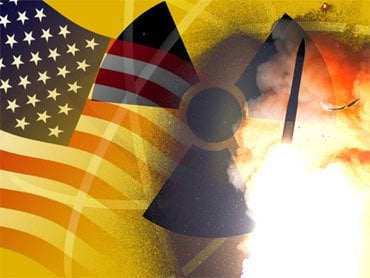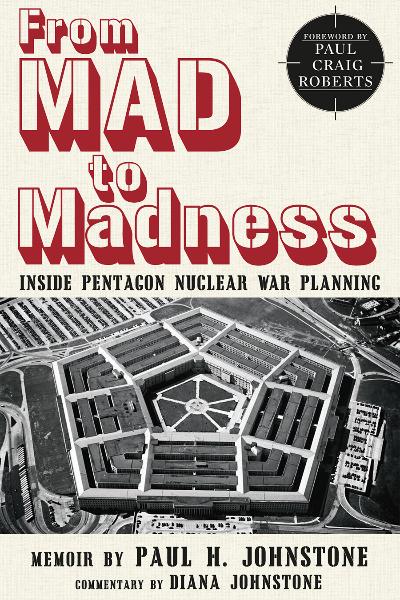From MAD to Madness: Playing Games with Nuclear War
Inside Pentagon Nuclear War Planning

The following text is an Excerpt from Paul H. Johnstone and Diana Johnstone’s Book published by Clarity. To order the book directly from the publisher click here.
In the early fifties, Air Force Target Intelligence was new, growing, finding its way. Everything was in a state of flux, and over all hung an air of urgency resulting from the threat of the Cold War.
The Cold War Atmosphere
The prevailing Pentagon presumption was that at almost any time the Russians would unleash their hordes upon Western Europe. In the Air Force Directorate of Intelligence, a Special Studies Group had been set up by General C.P. Cabell (who later moved over to CIA and was chief of operations there at the time of the 1961 Bay of Pigs fiasco, although it was Richard Bissell who was directly in control of that operation). This Group was charged with writing most of the long range strategic think-pieces for the Directorate.
Click book cover right to order directly from Clarity
 It was headed by Steve Possony, a Hungarian émigré who professed to be an expert on Communism in general and the Soviet Union in particular. Steve was the first of several Central European émigrés I met in the next few years who passed as experts on Communist Europe and who had at least some small influence on strategic thought and the formation of American policy. Others were Strausz-Hupé, Kissinger, Brzezinski and many lesser lights such as Leon Gouré and Helmut Sonnenfeldt. In every case I felt they were thinking, consciously or otherwise, not as Americans but as representatives of a lost cause in their native land, and I always believed they were used by the military because their ‘obsessions’ were so useful.
It was headed by Steve Possony, a Hungarian émigré who professed to be an expert on Communism in general and the Soviet Union in particular. Steve was the first of several Central European émigrés I met in the next few years who passed as experts on Communist Europe and who had at least some small influence on strategic thought and the formation of American policy. Others were Strausz-Hupé, Kissinger, Brzezinski and many lesser lights such as Leon Gouré and Helmut Sonnenfeldt. In every case I felt they were thinking, consciously or otherwise, not as Americans but as representatives of a lost cause in their native land, and I always believed they were used by the military because their ‘obsessions’ were so useful.
The one product of Possony’s group that I most distinctly remember was an annual appraisal of the strategic situation. And the reason I remember it, perhaps, is that every year that appraisal forecast a massive Russian land attack on Western Europe the following year. Several of us began to laugh about it after a while, but the forecast was always intoned awesomely and with superficial plausibility. I do not know whether many people who heard the briefings really believed the forecasts. I suspect many doubted it would really be next year, and thought it more likely the year after that or even later. But even doubters approved the forecast because, they reasoned, it was better to err in this direction than to minimize the danger. Above all, it was good to say things that emphasized the need for strong defenses.
This prediction of imminent mass attack by Russian hordes upon freedom’s bastions in Western Europe was, so far as I know, the specialty of Possony and company (maybe even they did not believe it, but it was, after all, a living). The general tone was not unlike the orientation briefings that were standard fare in those years for visitors to military bases of almost every sort — at least all of those I visited. These standard briefings were intended to explain the function and organizational status of the particular base or command, and as a one-time teacher I felt they were models of effective pedagogy. There was generally an articulate and accomplished raconteur, commonly a major or lieutenant colonel, armed with well-practiced topical jokes for starters, with a baton and a profusion of well executed charts and graphs and diagrams manned usually by a master sergeant. The introductory pleasantries varied from post to post and from time to time, but once these preliminaries were disposed of there was no doubt where the serious business would begin. It would begin with a series of charts, the first being Russia, colored red of course, with its boundaries of 1938, before the Russo-Finnish War and before the annexation of eastern Poland following the Nazi-Soviet pact of 1939 and the outbreak of World War II.
Then the red of Soviet Russia would flow into the areas taken from Finland, then from Poland in the 1939 seizure, then the red would move, one nation at a time, to cover the Baltic States, and after that Poland, Romania, Hungary, East Germany, Yugoslavia, Albania, North Korea, Czechoslovakia, China, and what we still called French Indochina. It was a red tide that was gradually overrunning the world. It was monolithic, centrally controlled and directed from Moscow, and the peoples of the areas turned red were Communist automatons, with never so much as a hint that they might have different cultural traditions or social values. The only suggestion of local differentiations was that poverty and hunger and sheer desperation induced human beings to become Communist automatons, which explained why areas in which there was political unrest of any sort were the areas we needed to keep a sharp eye on to prevent a Communist takeover.
It was almost always assumed that any war would be an unlimited war between the United States and our allies on one side, and the USSR and all her European Communist satellite states, plus China and North Korea on the other. The latter two did not count for much in those early days. Indeed the Korean War, although not a general war, was interpreted to confirm what almost everyone took for granted anyway, namely that the entire Communist bloc was a completely monolithic structure, with every major action dictated by Moscow and every slave state acting in concert.
By no means was this sort of presumption confined to the Pentagon. Even such a distinguished and broadly informed intellect as Secretary of State Dean Acheson subscribed to the doctrine. For instance, when in the last week of June, 1950, the North Koreans launched their attack on South Korea and President Truman returned from Missouri for a week of crisis conferences in Blair House, the basic premise of every attempt to understand the gravity of the situation and what our best response should be was that this was a Russian ploy and that the dominant question was what role in the overall strategy of Soviet plans for world conquest did this Korean venture play. Nearly twenty years later, when he wrote his State Department memoirs, Present At the Creation, Acheson still felt the same way. All this, despite the continued reporting, from 1945 on by our people on the spot, that the hostility of the regimes of both North and South Korea toward each other was so bitter that it was dangerously explosive and might erupt at any time. Our first occupation commander in South Korea had recommended we get out to avoid entanglement in a civil war between the two. And at least up to the time I write this, even though we have poured billions of dollars’ worth of military aid into South Korea, we have very carefully refrained from providing enough to give such confidence of military victory as to encourage their acknowledged aggressive tendencies.
Paul H. Johnstone was a senior analyst in the Weapons Systems Evaluation Group (WSEG) in the Pentagon. He was assistant director of three crucial studies on outcomes of nuclear war and the director of a fourth, on the impact on civilians. He also initiated a series of “critical incident” studies recounting decision-making problems, which led to the McNamara study of the errors of Vietnam war policy known as The Pentagon Papers and was one of its authors.

